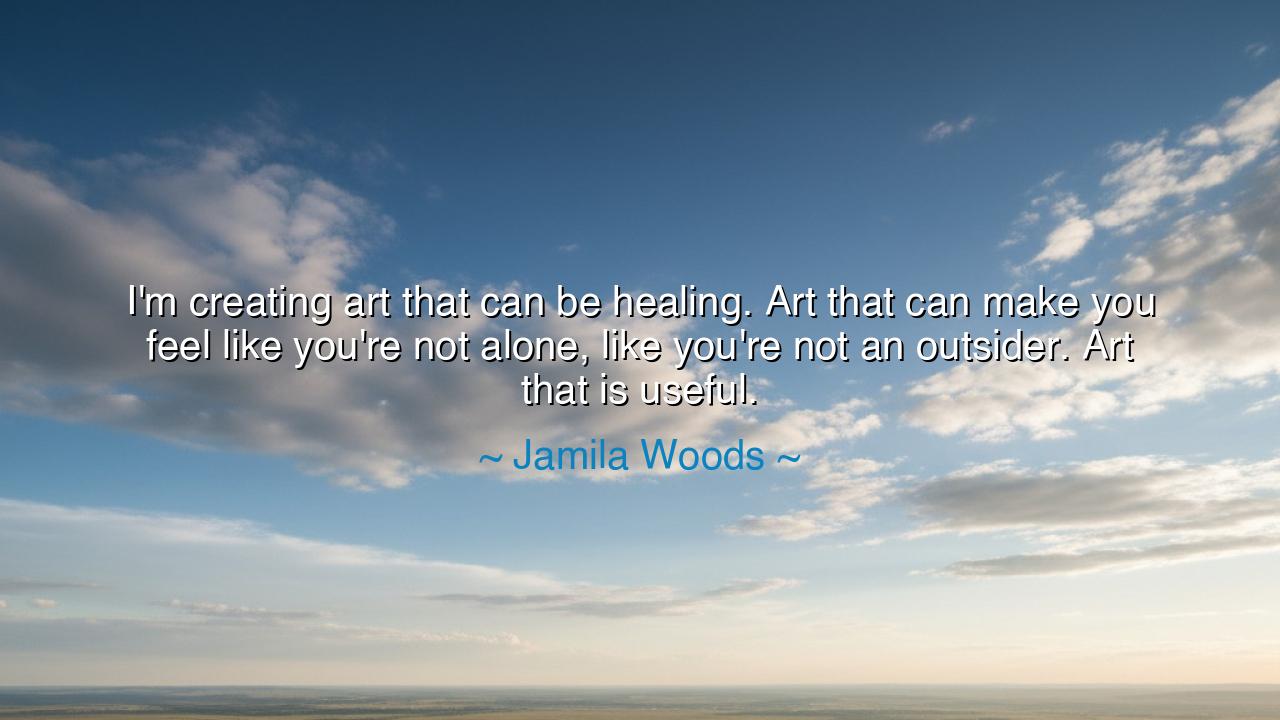
I'm creating art that can be healing. Art that can make you feel
I'm creating art that can be healing. Art that can make you feel like you're not alone, like you're not an outsider. Art that is useful.






The words of Jamila Woods — “I’m creating art that can be healing. Art that can make you feel like you’re not alone, like you’re not an outsider. Art that is useful.” — rise from the soul like a sacred vow. They echo the timeless understanding that art is not mere decoration, nor a pursuit of vanity, but a medicine for the spirit. In these words, Woods, a poet, singer, and voice of modern truth, claims her place among the ancient lineage of artists who have sought to mend the broken places of the world. Her declaration reminds us that art’s highest purpose is not to dazzle the eye or please the mind, but to heal the heart, to restore the connection between human beings and the divine spark that unites them.
The origin of this insight is as old as creation itself. Since the dawn of storytelling, song, and painting, humankind has turned to art in times of suffering, in times of loneliness, in times when words alone could not carry the weight of the soul. The cave paintings of our ancestors were not made for fame — they were prayers, symbols of belonging and protection. The hymns of the ancients were not performances — they were bridges between earth and heaven. Woods stands in this same lineage. When she speaks of art that makes one feel “not alone,” she invokes the ancient power of expression to unite the isolated, to tell each soul, “You are seen. You belong.” In a world that often divides and alienates, this is nothing less than a holy act.
To say that art is healing is to understand that creation itself is an act of transformation. Every poem, every melody, every brushstroke carries the potential to turn pain into beauty, and sorrow into meaning. For both artist and listener, art becomes a mirror of shared humanity — a light that exposes wounds not to shame them, but to heal them. Woods, who has written and sung about race, identity, and belonging, knows that to create such art is to labor with tenderness and courage. It is to stand between the personal and the collective, drawing from one’s own hurt to offer comfort to another. Healing art is born not from ease, but from empathy — from the deep knowing that one’s own scars can guide another toward wholeness.
There is a reflection of this truth in the life of Frida Kahlo, the Mexican painter whose art became her salvation. Crippled by pain, confined by injury, she poured her anguish and her hope onto the canvas. Her paintings were not meant to be “pretty”; they were meant to be true. In sharing her suffering, she offered others the courage to face their own. This is the essence of what Woods calls “useful art” — art that serves life, that uplifts rather than distracts, that calls forth strength from the wounded spirit. Both Kahlo and Woods teach us that art becomes immortal not by being admired, but by being needed.
Woods also speaks of art that helps people feel “not like outsiders.” This phrase is a lantern for the forgotten and the unheard. In every age, there are those who live on society’s edges — the poor, the marginalized, the dreamers whose voices are drowned out by the noise of power. For them, art is not a luxury; it is a lifeline. A song that speaks their truth, a poem that mirrors their struggle, a painting that reflects their face — these are acts of restoration. They remind the outsider that their existence matters. Great art, Woods teaches, does not exclude; it invites. It tells the lonely that they are part of the great human story, that their song belongs in the choir.
There is heroism in such creation. To make “art that heals” in a world addicted to spectacle is to swim against the current. It requires integrity — the courage to create from sincerity rather than ambition. The artist who seeks healing over fame must reject the temptation of applause and listen instead to the quiet call of purpose. Woods’s words are a challenge to all creators: to ask not “Will they like me?” but “Will this help them?” When art becomes a service rather than a display, it transcends ego and becomes sacred work. It becomes useful, in the truest and most ancient sense of the word — a gift that sustains life.
The lesson, then, is clear and urgent. Whether you are an artist, a teacher, or simply a soul who speaks and loves, make your expression a source of healing. Let your words, your work, your actions be useful — not shallow, but soulful. Create things that comfort, that inspire courage, that remind others they are not alone. If you have suffered, transform your suffering into something that helps another stand. If you have felt isolated, use your story to light the way for the next wanderer. This is not only the calling of the artist, but of the human being.
So, O creator and seeker of meaning, remember Jamila Woods’s vow: create art that heals, that connects, that serves. Whether your medium is song, speech, or simple kindness, let it carry the power to make another feel seen and whole. Do not fear the vulnerability this demands — for in baring your truth, you give others permission to find theirs. And in that shared act of creation, the world becomes less divided, less wounded, and more alive. For art, when it is useful, becomes more than beauty — it becomes the breath of compassion, the pulse of humanity, the eternal bridge between one heart and another.






AAdministratorAdministrator
Welcome, honored guests. Please leave a comment, we will respond soon